Uzbek national dishes – the proud of the nation
Uzbek ceramic ware has been known since the Silk Road. It is believed that the ancient city of potters was located on the territory of modern Rishtan on the site of the old city quarter of Chinniharon Mahalla. It is difficult to name the exact date of its appearance, but it is the most ancient settlement of the Ferghana Valley.
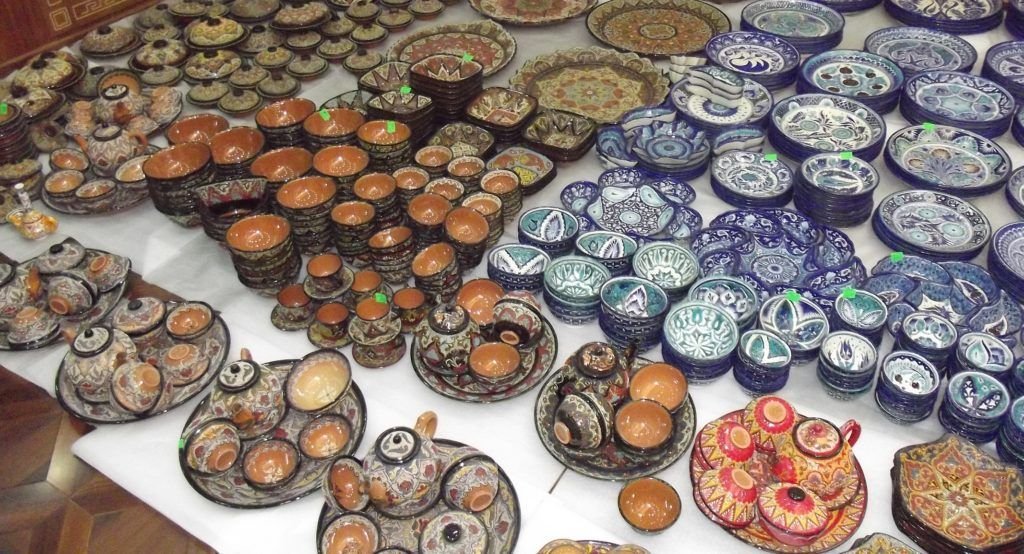
In 1900, Rishtan ceramic products were exhibited at the World Exhibition in Paris and were a huge success. Fortunately, traditions have been preserved. Rishtan today is famous for its ceramics.
In 1953, Uzbekistan began its own history of porcelain. A porcelain factory was built in Tashkent. Since 1961, the famous “Paxta” service, which is translated from Uzbek as cotton, began to be produced not only in Uzbekistan, but throughout the USSR. The next most popular was the “Golden Deer” service and the “Chinar” which did not have much success. Now complete sets of dishes can be seen in the museum. The Tashkent factory is no more exists. The production of porcelain dishes with a traditional Uzbek pattern is continued by others, including manufacturers from China and Turkey. But this is another product.

Despite the wide distribution of porcelain, ceramic national dishes do not lose popularity and are becoming more and more popular among both local residents and tourists. Travelers specially go to the famous pottery centers for Uzbek ceramics.
Types of national dishes from Uzbekistan
Uzbek cauldron (kazan) is familiar to everyone. A metal boiler with a sloping bottom is put on an open fire on tripods or lowered into the furnace. Without it, it is difficult to imagine Uzbek cuisine. The taste of plov or lagman cooked in a cauldron cannot be repeated in pans and plates. Now the cauldron is made from different types of metal, but cast iron remains the most preferred. Although you can find aluminum, but not in Uzbekistan. Copper cauldrons are more suitable as exhibits of museums. They are too toxic to cook in them.
National dishes made of ceramics are produced by local factories, for example Rishtan factory, for a wide consumer. Unique items are not rare, performed by masters on potter’s wheels in single copies. But they are more works of art than kitchen utensils.

The most favorite drink in Uzbekistan is tea. They drink it, one might say, ritually. By the way the owner pours tea to the guest, you can determine the social status of the latter. And by the way the guest drinks it, it’s not difficult to see what kind of relationship he has with the host. Tea is not poured into cups, but into Uzbek pialas. Before tea came to Uzbekistan, tea drinking came from ceramic pialas. The place of manufacture of the dishes, and sometimes the name of the master, was determined by their color and pattern.
Uzbek handmade ceramics
Pottery is developed in several regions of Uzbekistan, and each has its own unique features.
It is no coincidence that the Ferghana Valley is considered the ancient center of Uzbek ceramics. Its southern part, where the city of Rishtan masters is located, is located in the Alai foothills, at an altitude of 482 meters, on the border with Kyrgyzstan. The local clay of the area is ideal for pottery.
The material has exceptional strength and a reddish tint, which gives the dishes a special color. In the production of glaze for dousing dishes with Ferghana artists, a component such as the ashes of plants from Ferghana foothills is used. And each master has his own secret.
A drinking bowl is a necessary attribute of Uzbek tea drinking. The bowl is a hemispherical cup without handles and is always part of a set of dishes for plov. If we talk about the Uzbek services, then the most common is tea. They include a teapot, almost perfect shape with an exquisite pattern, a large plate, Uzbek-style lagan, and 4-6 pialas for tea.
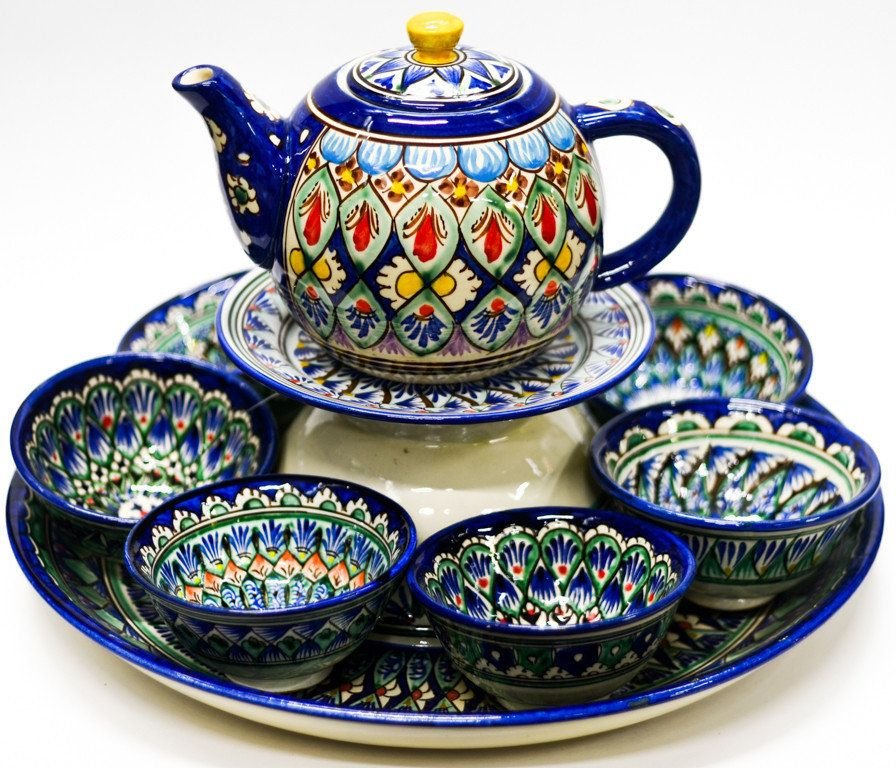
Handmade Uzbek tea sets can be purchased from Rishtan masters. In Khorezm, lagans, decorative dishes and pialas prevail. The painting on the dishes is a noble pattern with all shades of blue, achieved through the use of blue cobalt in the glaze. Often there are geometric shapes.
It was or was not, but a long time ago, when animals and birds knew how to talk, and roses were enchanted girls, the shakh lived in the city of Margilan. He had three sons and a daughter. No one had such magnificent and thick hair as the princess. She braided them in many, many braids, that’s why they called her affectionately the Hazor-geysu – Princess of Thousand of braids.
There is a unique dish – badia. It serves Khorezm plov, the remaining fat from which flows into a special hole in the tub. Badia is deeper than the creeper and has high sides.
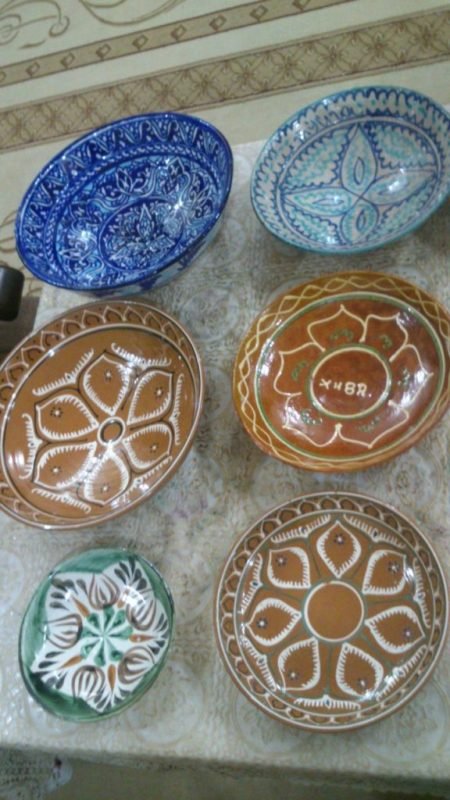
Local jugs with a solid thick glaze inside are also surprising. From the outside, only part of the product is covered with glaze. This design makes it possible to keep the inside of the jug cool in extreme heat according to the principle of a thermos. Pouring water over that part of the jug that is not covered with glaze, cool the contents of the jug. Since the water first impregnates the porous clay, and then evaporates.

The ceramics of this region are fragile and are widely used for the production of Uzbek tiles. There are three ceramic schools. It is difficult to describe the originality of the drawings and styles of each. But everyone can appreciate the musical sound made by ceramics, if you click on it.
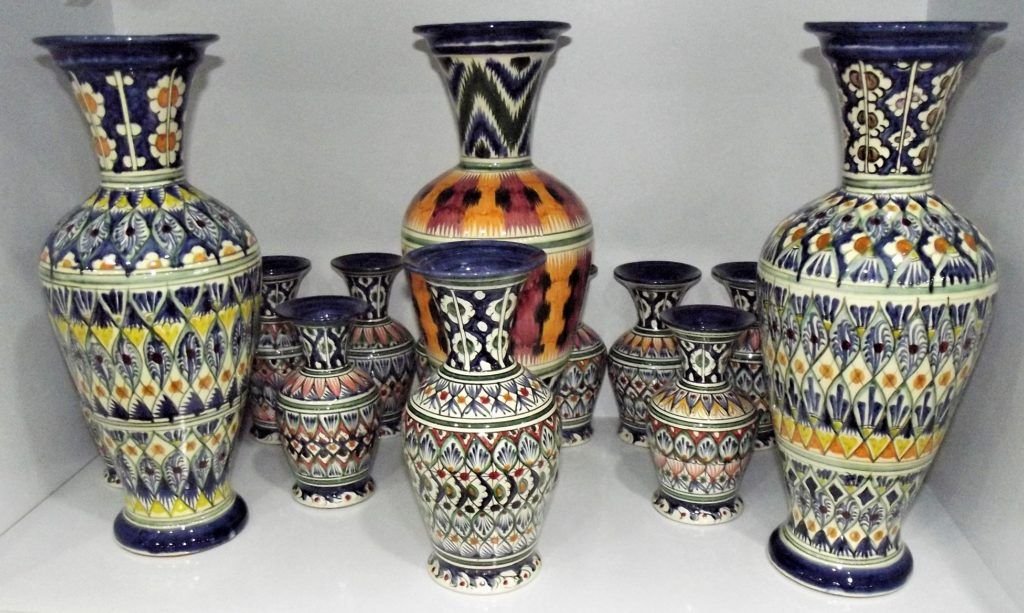
Uzbek metal and cast iron dishes
Cast iron utensils are distributed throughout Central Asia and Uzbekistan. Frying pans of all sizes, stupas for chopping spices, heavy pots. But the central place in the kitchen is occupied by the Uzbek cauldron. Cauldrons from Namangan were recognized as the best for the high quality of cast iron and the thick walls of the product. Truly high-quality products only get better and more valuable over time. Therefore, they can be found on sale infrequently, even in the markets of Uzbekistan. This heirloom and irreplaceable thing in the household is inherited.
The secret is that a long-used cauldron is covered with the “right” soot, the function of the coating is, and not only protects the dish from burning, but also makes the food even tastier. The traditional form of a cauldron assumes a semicircular bottom. Given the use of plates, modern cauldrons began to be produced with a flat bottom outside. Inside, the cauldron still retains its historic rounded shape. The apartments often use cast iron cauldrons with an aluminum cover.

After purchase, a new product must be calcined. The work is laborious and requires certain knowledge and skill.
A stainless steel skimmer with a wooden handle for cooking pilaf in a cauldron has no alternative. It’s not only mixes the zirvak and smoothes the surface of the rice, but also checks its readiness for the sound that is heard from patting the rice with a slotted spoon. The size of the skimmer should match the cauldron. For example, for a volume of 30 liters, you will need a slotted spoon with a length of at least 62 cm, but not less than 15 in diameter.
Patterns on dishes from Uzbekistan
In Uzbekistan, porcelain, earthenware and ceramic dishes are produced and used. In the traditional teahouse, you can see porcelain and faience with the famous paxta pattern on plates. Bowls, teapots and large fruit dishes are also made in the style of pakhtagul. Blue colors are used more often, less often – black and red, and very rarely – green color scheme.
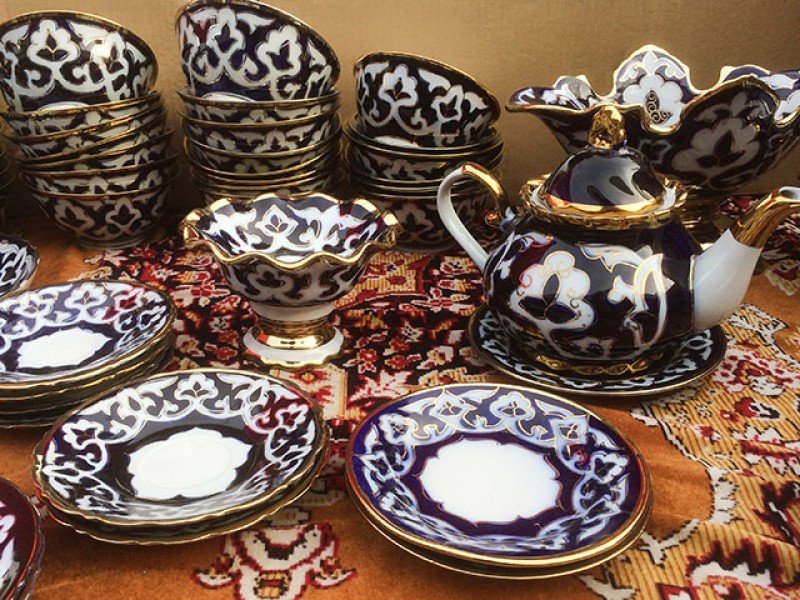
But pilaf and other hot things will be brought on a lagan – a large ceramic plate with an Uzbek pattern. Most likely, it will be ceramic and not handmade, but the national flavor of this will not decrease, as well as the wonderful taste of fragrant plov.
The national Uzbek ornament is beautiful and diverse. It’s often based on ancient symbolism, the meaning of which is not always clear.
Today, Bukhara masters began to reproduce on the dishes the technique of ancient Arabic script. Gijduvan craftsmen using old technologies create bowls with thicker and larger walls than usual and are made in tan. These are works of high art that can hardly be called just utensils.
Schools of manufacturers from different regions of Uzbekistan
By the 60s of the last century, Uzbek ceramic dishes were made in Rishtan, Gijduvan, Shakhrisabz, Samarkand, Kattakurgan and Tashkent. And also in Surkhandarya, Kashkadarya and Khorezm regions. It has retained a certain form and style inherent in each region.
According to experts, three main schools are now preserved: Ferghana (Rishtan, Gurumsay), Bukhara-Samarkand (Samarkand, Urgut, Gijduvan) and Khorezm. The latter turned out to be the most conservative, with almost no interspersed new elements.

Unfortunately, the Uzbek Shakhrisabz school with its bright sunny colors and unusual mystical painting on the dishes is no longer there. By the beginning of the 90s of the last century, the school ceased to exist. But the hope remained that it will be possible to restore, thanks to the masters who remember the basics, the remaining books and the enthusiasm of the connoisseurs of beauty. In the Soviet era, there were three porcelain factories on the territory of Uzbekistan: Tashkent, Samarkand and Kuvasay. There, talented artists manually painted high-quality porcelain in the style of pakhtagul.
Unfortunately, out of three, none of the enterprises remained. We would like to believe that the last porcelainists of the Kuvasay plant, known in the republic and recognized abroad, will be able to revive beautiful porcelain traditions in Uzbekistan.
Uzbek ceramics in this sense are more fortunate. The Rishtan factory, built in 1960, is still operating, and products can be seen on store shelves all over Uzbekistan at affordable prices.
Fans of unique handmade ceramics from famous masters will not be disappointed. They live and create on Uzbek soil, including Rishtan. Also on our site you can find many originals of Uzbek ceramics.
